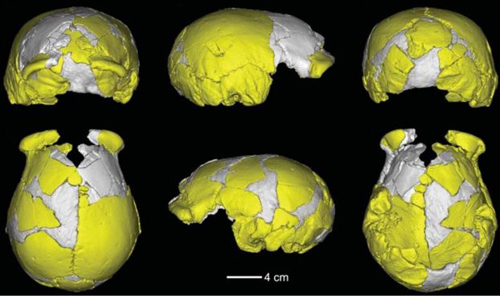Ancient Hominin Skulls from the Late Pleistocene of China
Ancient Hominins of China
Two fragmentary skulls found in eastern China (Henan Province), have shed light on the ancient hominins who inhabited that part of the world before the arrival of our own species (H. sapiens).
Palaeoanthropologists know that Europe and western Asia was the domain of the Neanderthals (Homo neanderthalensis) before they were displaced by H. sapiens which had migrated out of Africa. However, frustratingly, remains belonging to the equivalent human populations in eastern and central Asia have rarely been found. The two skulls, although lacking facial bones, have provided researchers with tantalising evidence with regards to the type of human species that lived in this region around 125,000 to 105,000 years ago.
Views of the Ancient Skull (Xuchang 1)
Picture credit: Dr Wu Xiujie
The skulls were excavated during a series of field studies undertaken at a site in Lingjing, Xuchang County, between 2007 and 2014. The fossils were found in association with a wealth of mammal remains including deer, horse, Coelodonta (Woolly Rhino), ancient cattle, gazelles and Megaloceros (giant elk).
The scientists, which included researchers from the Institute of Vertebrate Palaeontology and Palaeoanthropology (Beijing) and the Chinese Academy of Sciences have dated the skulls to between 125,000 and 105,000 years ago. The overlying layers of sediment date from less than 100,000 years ago.
A Mosaic of Ancient and Modern Features
The skulls show a range of morphological features with differences from and similarities to their European and western Asia contemporaries.
Co-author of the study, Professor Erik Trinkaus explained that although the skulls had some features that mirrored what has been found in Neanderthal skulls, some characteristics, like a low, broad braincase, link them to even earlier humans from the same region, who lived in the Middle Pleistocene.
The professor commented:
“There’s a certain amount of regional diversity at this time, but also there are trends in basic biology that are shared by everybody and the supposed Neanderthal characteristics show that all these populations were interconnected.”
Big Brains?
One of the skulls, the specimen referred to as Xuchang 1, is estimated to have had a very large endocranial volume. This suggests a large brain, a brain size of around 1,800 cubic centimetres, which is at the high end for Neanderthal and early modern humans. Indeed, within our own species, although there is considerable variation in brain volume, a endocranial volume of 1,800 cm3 would be exceptional.
Scans of Xuchang 1 Suggests a Remarkable Brain Size
Picture credit: Dr Wu Xiujie/Science
Corresponding author for the study, published in the journal “Science”, Dr Wu Xiujie of the Institute of Vertebrate Palaeontology and Palaeoanthropology stated:
“This morphological combination, particularly the presence of a mosaic not known among early Late Pleistocene humans in the western Old World, suggests a complex interaction of directional palaeobiological changes and intra and inter-regional population dynamics. From their fossil record, eastern Asian late archaic humans have been interpreted to resemble their Neanderthal contemporaries to some degree, with considerations of whether the fragmentary remains of the former exhibit features characteristic of the latter. Yet it is only with the discovery of two human crania (plus additional elements), that the nature of these eastern Eurasian early Late Pleistocene archaic humans is becoming clear.”
The Xuchang skulls provide palaeoanthropologists with an important window into the biology and population history of early Late Pleistocene eastern Eurasian people. As such, they are a critical piece in our understanding of the human evolutionary background to the subsequent establishment of modern human biology across the Old World, a process that was already underway in eastern Africa and (apparently), further south in eastern Asia.
An Ancient Hominin with Links to the Denisovans?
How these ancient hominins are related to the enigmatic and mysterious Denisovans (if they are closely related, for that matter), remains uncertain. The absence of any teeth restricts the comparisons between these two skulls and the Denisovan ascribed fossil material, which includes a large tooth. Researchers hope that perhaps some ancient, uncontaminated DNA can be recovered from the site. Finding genetic material would permit whether these skulls represent a link to the Denisovans or whether they represent a distinct hominin lineage to be tested.
Everything Dinosaur acknowledges the help of the Chinese Academy of Sciences in the compilation of this article.
Visit Everything Dinosaur’s website: Everything Dinosaur.



